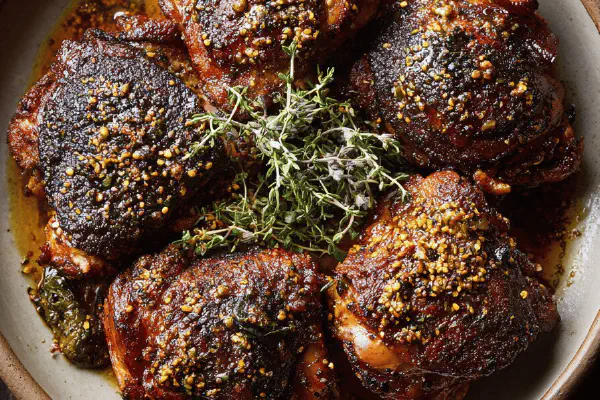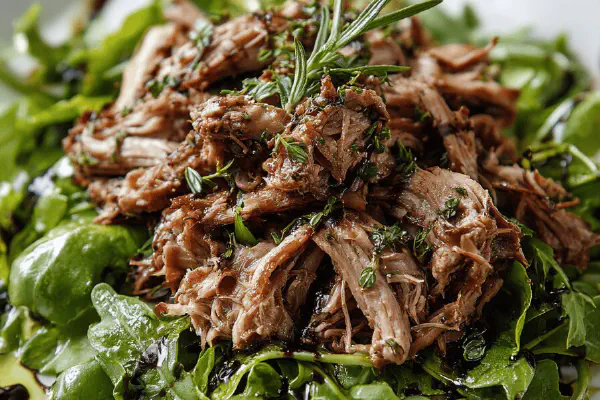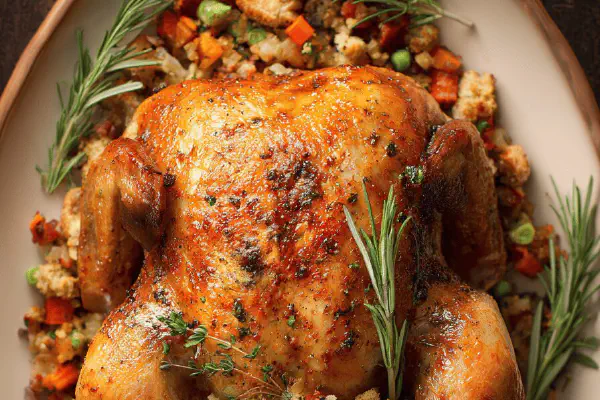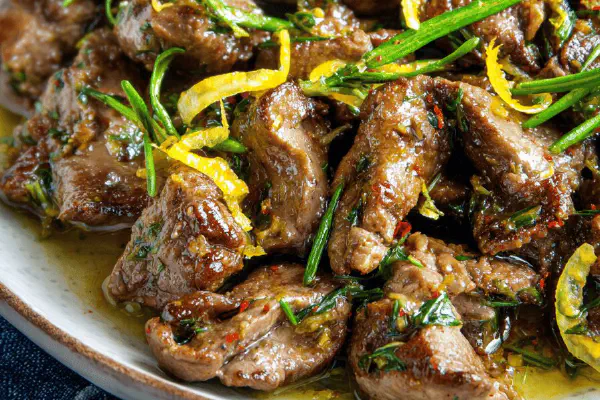Turkey Thigh Confit

By Emma
Certified Culinary Professional
Ingredients
Spiced Salt
- 45 g coarse salt
- 20 ml (1 tbsp) cumin seeds
- 10 ml (2 tsp) yellow mustard seeds
- 6 allspice berries
- 2 dried bay leaves, torn
- 2 cloves
- 1 sprig rosemary, leaves stripped
Turkey Thighs
- 2 turkey thighs about 1 kg each
- 1.8 liters rendered duck fat
About the ingredients
Method
Spiced Salt
- 1. Toast cumin and mustard seeds in dry skillet until fragrant, about 2 minutes, shaking constantly to prevent burning. Let cool.
- 2. Grind cooled seeds coarsely in mortar or spice grinder. Combine with salt, allspice, torn bay, cloves, and rosemary in a bowl; mix thoroughly.
Turkey Thigh Preparation
- 3. Spread turkey thighs out in a single layer in a glass or ceramic dish. Season each with 15 ml (3 tsp) of spiced salt rub, rubbing it deep into the flesh and under skin where possible. Cover tightly and refrigerate 22-26 hours. I like to turn thighs halfway so salt flavor distributes evenly.
- 4. Preheat oven to 130°C (265°F), placing rack in center. The low temp lets fat cook slow, rendering collagen without drying.
- 5. Remove thighs from fridge. Rinse off excess salt under cold running water — don’t skip this or meat will be too salty. Pat dry with paper towels until skin is almost tacky.
- 6. Transfer turkey thighs to a heavy-bottomed ovenproof pot or deep casserole, skin side down. Melt duck fat gently on the stove over low heat until fluid and fragrant.
- 7. Pour duck fat slowly over the thighs until fully submerged. If fat covers unevenly, press meat under fat or add hot fat to cover completely, limiting air exposure.
- 8. Cover vessel tightly with lid or foil to trap moisture. Bake thighs for 2 hours, then carefully flip each piece; continue cooking 1 hour until tender enough the meat pulls away with finger pressure like soft butter. Internal temp not as critical here; texture and easy flake are clues.
- 9. Remove pot from oven; hold turkey thighs in fat. Let cool slightly before draining excess fat. Bone out the meat with your fingers or a fork, discarding skin and bones — they harbor off-flavors and tough bits.
- 10. Store shredded confit in a sealed container, submerged lightly in fat to prevent drying. Keeps well 5-7 days refrigerated. Freeze if more storage needed; thaw slowly in fridge before use.
Serving Ideas
- 11. Serve warm atop a peppery green salad with sharp vinaigrette or crisp pickled veggies. Can be reheated gently in skillet with a splash of stock, or used cold, sliced, in sandwiches or on rustic platters.
Troubleshooting and Tips
- 12. Too salty? Rinse thoroughly, soak 15 minutes in cold water after rinsing if needed, then dry well. Too dry? Cook lower and slower next time — confit is forgiving but heat extremes toughen meat. Use fat from different poultry if duck fat scarce — goose fat best substitute, or clarified pork fat if tolerated.
- 13. Save bones: simmer with aromatics for a rich stock to use in future sauces. No fat? Slow braise in duck stock with skin on to keep moist, then crisp up under broiler for texture.
- 14. Key: patience. Salt cure encourages flavor and moisture loss, but long, gentle cooking in fat seals juices. Don't rush stage or flip too often; that disrupts slow rendering and final texture.
- 15. Seasoning swap: cumin and mustard seeds bring earthiness, changing aroma profile away from brighter coriander and pepper pink. Add a pinch of smoked paprika at the end for extra layer or diced garlic in fat for aroma.
Cooking tips
Chef's notes
- 💡 Coarse salt over fine. Pulls moisture gently, seasons slow. Toast cumin and mustard seeds lightly, very watchful for bitter burn. Grind coarse bites. No shortcuts on spice prep or flavor tanks. Refrigerate thighs 22-26 hours, flipping once mid-way. Too long toughens; too short lacks depth. Rinse salt off thoroughly or meat screams salty. Pat dry until tacky for fat cling.
- 💡 Oven low and slow. 130°C—not hotter. Keeps collagen intact; meat falls apart quietly under finger pressure. Flip once midway, not more—excess stirs fat out, ruins texture. Submerge thighs fully in just-melted duck fat; air pockets = dry spots, oxidize fast. Press meat under fat if needed; reheating later relies on that sealed moisture. Skin and bones tossed after. They hold bitter bits, no use here.
- 💡 Duck fat best, goose fat next. Clarified pork fat usable but watch low temp tolerance; breaks down quicker. Melt fat gently on low heat, don’t scorch. Pour warm fat slowly to cover meats. Encourage even submersion to block air. Store confit submerged in fat; keeps moist 5-7 days refrigerated, longer frozen. Warm gently in pan with stock splash or serve cold slices as salad topper. No fat? Slow braise skin-on turkey thighs in duck stock to retain juiciness then crisp skin under broiler.
- 💡 Spice swaps shift profile big. Cumin and mustard seeds replace coriander and pink pepper. Earthy, subtle heat replaces fresh brightness. Add pinch smoked paprika at end for smoky depth or dice garlic into fat for aroma boost. Rosemary swaps thyme for a sharper herbal note better aligned with cumin’s earthiness. Keep herbs whole or torn; soft leaves meld flavors, freeing oils but avoid over powering salt rub.
- 💡 Patience wins over speed. Salt cure pulls moisture, don’t skimp or rush stages. Too salty? Rinse, soak 15 min cold water after, then dry. Too dry? Lower oven temp even more, extend cooking. Flip thighs sparingly. Use bones for stock; simmer with aromatics for future sauces. Saving fat to preserve confit means no skimming. Cook fat temperatures matter; too hot ruins gentle cook, too cold slows rendering. Watch skin tightly glisten. That’s done cue.
Common questions
How long to salt cure turkey thighs?
Around 22-26 hours fridge. Flip once halfway for even salt. Too short, minimal flavor; too long, meat firms up. Fine salt no good. Must rinse off salt fully before cooking or it’ll overwhelm taste buds.
Can I use other fats instead of duck fat?
Yes, goose fat great substitute, same mouthfeel. Clarified pork fat works but lower heat limit, breaks down easier. If no fat, slow braise thighs in duck stock skin-on, then crisp skin under broiler for texture.
Meat too salty or dry after cooking?
Rinse well before cooking, soak in cold water 15 minutes if over salt. Pat dry thoroughly. If dry, lower oven temp next time, cook longer slow. Flip thighs gently once mid-cook only—too often leaks moisture, toughens meat.
How to store and reheat confit turkey?
Keep shredded confit submerged in fat sealed in fridge up to a week, freeze for longer. Warm gently in skillet with splash stock; avoid high heat. Can serve cold sliced on salads or sandwiches. Fat layer protects from drying; don’t skim off.



